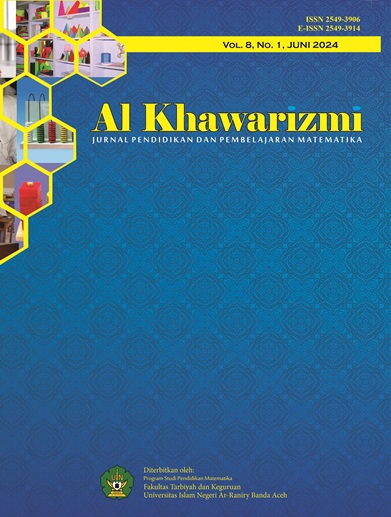Validity of E-Modules for Teaching Fractions Through Realistic Mathematics Education with The Context of Sacrifice Worship (Ibadah Kurban)
DOI:
https://doi.org/10.22373/jppm.v8i1.22850Keywords:
E-Module, Teaching Fractions, Realistic Mathematics Education, Sacrifice WorshipAbstract
Fraction is one of the difficult topic for students. One way to reduce students’ difficulties is to implement Realistic Mathematics Education (RME) by integrating Islamic values such as Sacrifice Worship (Ibadah Kurban). In addition, the use of technology to integrate sacrificial worship in fraction learning is also expected to increase students' interest in learning in the 21st century and can improve students' understanding. Therefore, it is necessary to develop an e-module for learning fractions through RME with the context of Sacrifice worship. The developed e-module contains learning trajectories, live worksheets, videos, and post-tests. This type of research is research and development which follows the stages of Plomp, especially in the prototyping and assessment stages. The instruments in this study were validation sheets. The validators consisted of one mathematics education lecturer and two Banda Aceh City junior high school teachers. Based on the validity test it was concluded that the e-module meets the valid criteria. The implication of this research is the development of e-modules needs to be continued to test practicality and effectiveness.References
Ariyanto, A., Priyayi, D. F., & Dewi, L. (2018). Penggunaan Media Pembelajaran Biologi Di Sekolah Menengah Atas (SMA) Swasta Salatiga. BIOEDUKASI (Jurnal Pendidikan Biologi), 9(1), 1. https://doi.org/10.24127/bioedukasi.v9i1.1377.
Carpenter, T. P., Corbitt, M. K., Kepner, H. S. , Lindquist, M. M., &Reyes, R. E. (1981 ). Results from the Second Mathematics Assessment of Educational Progress. Reston, VA: National Council of Teachers of Mathematics.
Johar, R., Zubainur, C. M., Khairunnisak, C., & Zubaidah, T. (2021). Membangun kelas yang demokratis melalui pendidikan matematika realistik. Banda Aceh: Syiah Kuala University Press.
Khabibah S. (2006). Pengembangan Model Pembelajaran Matematika dengan Soal Terbuka untuk Meningkatkan Kreativitas Siswa SD[Disertasi]. Surabaya: UNESA.
King, S. O., & Robinson, C. L. (2009). “Pretty Lights” and Maths! Increasing student engagement and enhancing learning through the use of electronic voting systems. Computers and Education, 53(1), 189–199. https://doi.org/10.1016/j.compedu.2009.01.012
Mamede,E.(2010). Issues On Children’s Ideas of Fraction when Quotient Interpretation is Used. CERME 7 p 1.
Meryansumayeka, Putri, R. I. I., & Zulkardi. (2019). How students learn fraction through pempek lenjer context. Journal of Physics: Conference Series, 1166(1). https://doi.org/10.1088/1742-6596/1166/1/012028.
Muslimin, Putri, R. I. I., Zulkardi, & Nyimas, A. (2020). Learning integers with realistic mathematics. Journal on Mathematics Education, 11(3), 363–384.
Oktaviana, I., Sumitro, S. B., & Lestari, U. (2015). Pengembangan Bahan Ajar Berbasis Penelitian Karakterisasi Protein Membran Sperma Pada Matakuliah Bioteknologi. Florea : Jurnal Biologi dan Pembelajarannya, 2(2). https://doi.org/10.25273/florea.v2i2.413.
Plomp, T., & Nieveen, N. M. (2010). An introduction to educational design research.
Purwanti, A. D. (2012). Penerapan pendekatan kontekstual untuk meningkatkan minat belajarsiswa pada pembelajaran IPA di sekolah dasar. Jurnal Ilmiah Guru “COPE”, 16(2), 1-6.
Riswati. (2015). Penggunaan Kalimat Efektif Dalam Karya Tulis Ilmiah Mahasiswa. Gramatika Jurnal Penelitian Bahasa Dan Sastra Indonesia, 1(2), 221–227.
Siegler, R. S., Duncan, G. J., Davis-Kean, P. E., Duckworth, K., Claessens, A., Engel, M., Susperreguy, M. I., & Chen, M. (2012). Early Predictors of High School Mathematics Achievement. Psychological Science, 23(7), 691–697. https://doi.org/10.1177/0956797612440101.
Siegler, R.S., Lisa, K.F., Drew, H.B., & Xinlin, Z.(2013). Fraction: the new frontier for theoris of numerical. Development Trend in Cognitive Sciences, 17, 13.
Subekti, M. A. S., & Prahmana, R. C. I. (2021). Developing interactive electronic student worksheets through discovery learning and critical thinking skills during pandemic era. Mathematics Teaching-Research Journal, 13(2), 137–174.
Sumandya, I. W., & Mahendra, I. W. E. (2020). Developing vocation based mathematics e-module in linear program material. International Journal of Psychosocial Rehabilitation, 24(6), 1741–1752.
Syahroni, M. W., Dewi, N. R., & Kasmui. (2016). The effect of using digimon (Science digital module) with scientific approach at the visualization of students’ independence and learning results. Jurnal Pendidikan IPA Indonesia, 5(1), 116–122. https://doi.org/10.15294/jpii.v5i1.5800.
Treffers, A. (2012). Three dimensions: A model of goal and theory description in mathematics instruction. Reidel Publishing Company.
Ulpah, M., & Novikasari, I. (2020). Developing Islamic Context-Based Learning Materials in Increasing Students’ Mathematical Understanding. Al-Jabar : Jurnal Pendidikan Matematika, 11(1), 29–38. https://doi.org/10.24042/ajpm.v11i1.5432.
Wijayanti, K., & Ghofur, M. A. (2021). Pengembangan Media Pembelajaran E-Modul Bank Dan Sistem Pembayaran Berbasis Android Untuk Peserta Didik Kelas X. Jurnal Pendidikan Ekonomi, 14(1), 1–14.
Winatha, K. R., & Abubakar, M. M. (2018). The Usage Effectivity of Project-Based Interactive E-Module in Improving Students’ Achievement. Jurnal Pendidikan Teknologi dan Kejuruan, 24(2), 198–202. https://doi.org/10.21831/jptk.v24i2.20001.
Zakiyah, H., Purnomo, D., & Sugiyanti, S. (2019). Pengembangan E-modul dengan Pendekatan Kontekstual pada Materi Bilangan Bulat SMP Kelas VII. Imajiner: Jurnal Matematika dan Pendidikan Matematika, 1(6), 287–293. https://doi.org/10.26877/imajiner.v1i6.4855.

